![]()
![]()
![]()
Use LEFT and RIGHT arrow keys to navigate between flashcards;
Use UP and DOWN arrow keys to flip the card;
H to show hint;
A reads text to speech;
74 Cards in this Set
- Front
- Back
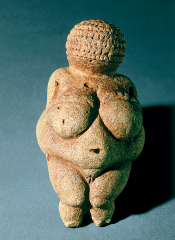
|
Woman of Willendorf c. 25,000 BCE limestone, 4.5" tall
Stone Age no face, small for travel, fertility? |
|
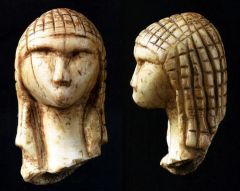
|
Woman from Brassempouy c 22,000 BCE Ivery, 1.5" tall (Musee des Antiquites Nationales St.-Germain-en-Laye)
Stone Age Ivory, chipped with tools |
|
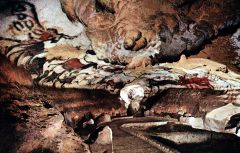
|
Caves at Lasaux, general view and details c. 15,000 BCE pigment on limestone rock
Stone Age versimilitude, crude stick figures, compare to Hunter from Catal Huyuk |
|
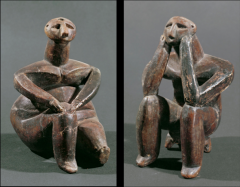
|
Male and Female figures from Romania c. 4000-3500 BCE Clay (Natioonal History Museum of romania, Bucharest)
Stone Age Human form, specialization, had to practice |
|
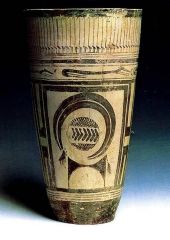
|
Painted Beaker from Susa c. 5,000-4,000 BCE 11.5" (Louver, Paris)
Stone Age/Ancient Near East think, delicate, registers, geometric animals/figures |
|
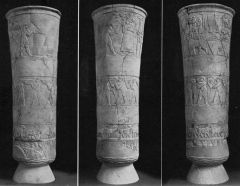
|
Vase from Uruk c.3,500-3,000 BCE Alabaster (Iraq Museum, Baghdad)
Stone Age/ Ancient Near East registers, read bottom-top, urial grounds, animals-people-offering goddess items, egyptian profile |
|
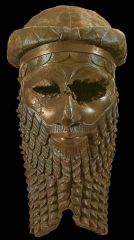
|
Head of an Akkadian Ruler c. 2,300-2,200 BCE bronze, 12" (Iraq Museum, Baghdad)
Stone Age/ Ancient Near East eyes gouged out, representation of ethnicity, portrature vs representation |
|

|
Stele of Naramsin c. 2,300-2,200 BCE pink sandstone, 6'8", Louvre, Paris
Stone Age/Ancient Near East landscape, important figure is biggest, abstract dieties, hierarchy |
|
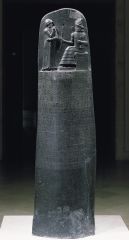
|
Law/Stele of Hammurabi c. 1760 BCE basalt, 7'4" Louvre, Paris
Stone Age/Ancient Near East ruler paying homage to holy figure, penalties for crimes, limit excessive punishments
|
|
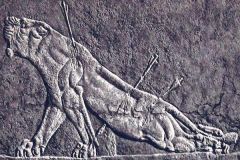
|
Assyrian Dying Lioness c. 650 BCE (7thc BCE) Limestone (British Museum, London)
Ancient Near East Pathos, loss of power, feel the character's pain |
|
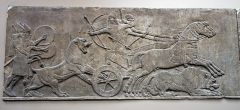
|
Assyrian Lion Hunt, c. 6500 BCE LImestone (British Museum, London)
Ancient Near East Asurnasipal II, ritual killing, unfair fight, layering to show depth |
|
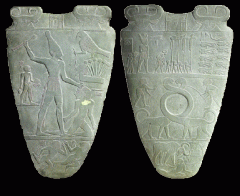
|
Palette of Narmer c. 3200, BCE slate (Egyptian Museum, Cairo)
Egypt predynastic, Name at top, steps to become ruler, unite north and south Egypt, CANON BODY RATIO |
|
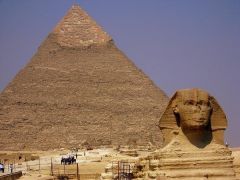
|
Pyramid of Khafra c. 2650 BCE Giza
Egypt |
|
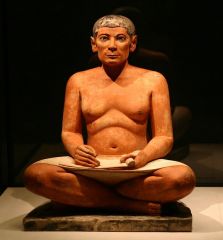
|
Seated Scribe c. 2600 BCE painted limestone (Louvre, Paris)
Egypt more human-like features (wrinkles, soft hands) |
|

|
Mycerenius and Queen c. 2600
Egypt golden ratios, left foot forward |
|
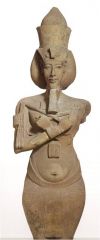
|
Akhenaten, colossal statue c. 1375 Karnak (Egyptian Museum, Cairo)
Egypt less idealized features |
|
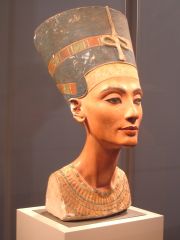
|
Bust of Queen Nefertite c. 1360 BCE painted limestone (Egyptian Museum, Berlin)
Egypt |
|

|
Fisherman from Akrotire, Thera (Santorini) c. 1550 BCE Wall painting (National Archaological Museum)
Ancient Aegean naked god? |
|
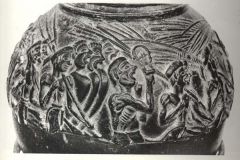
|
Harvester Vase c. 1500 BCE steatite (Herakleion Museum, Crete)
Ancient Aegean |
|
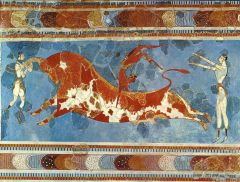
|
Minoan Bull Jumping c. 1550-1450 BCE Palace Complex
Ancient Aegean
|
|
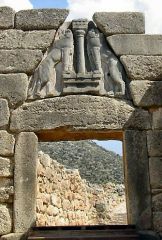
|
Lion / Lioness Gate c. 1500-1300 BCE limestone relief, Mycenae
Ancient Aegean Corbeled arch, war like |
|

|
Young Girl Gathering Saffron c. 1500 NCE (National Museum, Athens)
Ancient Aegean |
|
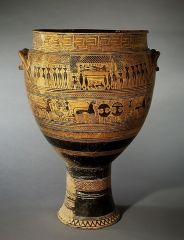
|
Dipylon Vase, Attic Geometric Amphora 8th century
Greece used for funeral processes, very fine |
|
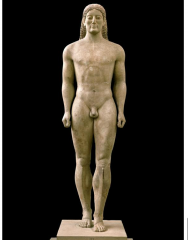
|
Anavysos Kouros c. 530 BCE (6thc BCE) Marble
Greece forms blend into one another smoother |
|
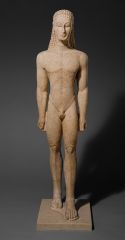
|
New York Kouros c. 580 BCE (6thc BCE) marble
Greece angled and idealized proportions |
|
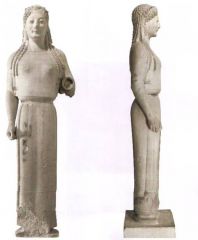
|
Peplos Kore c. 530 BCE (6thc BCE) marble (Acropolis Museum, Athens)
Greece |
|

|
"Fancy" Kore c. 510 BCE (6thc BCE) marble, (Acropolis Museum, Athens
Greece |
|
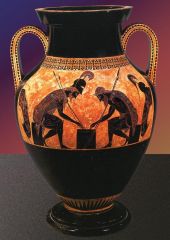
|
Exekias, Black Figure Amphora with Ajax and Achilles c. 540-530 BCE (6thc BCE) (Vatican Museum, Rome)
Greece long firing process |
|
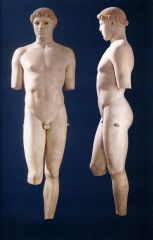
|
Kritios Boy c. 480 BCE (5thc BCE) marble (Acropolis Museum, Athens)
Greece contra-posto |
|
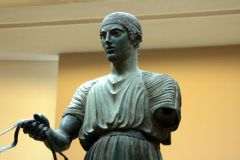
|
Bronze Charioteer c. 470 BCE (5thc BCE) Archealogical Museum, Delphi
Greece inlaid eyes |
|
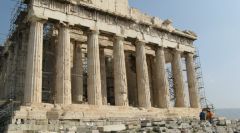
|
Acropolis 5th century, BCE
Greece to the goddess Athena, house of the god/goddess Doric Order, capital-broad columns-entabliature (on top)- frieze (up and down lines) - triglyph and metopes |
|
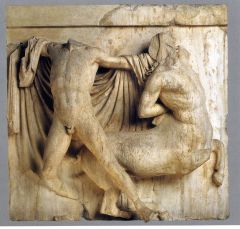
|
Parthenon, Metope Sculpture with Lapitha nd Centaur c. 438-432 BCE (5thc BCE) (British Museum, London)
Greece |
|
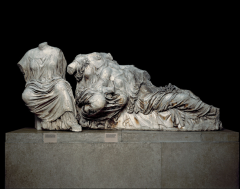
|
"Three Graces" / "The Fates". East pediment of the Parthenon c. 438-431 BCE (5thc BCE) (British Museum, London)
Greece |
|
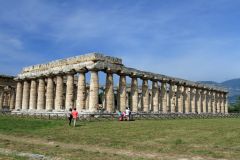
|
"Basilica" / Temple of Hera, Paestum, Italy c. 540 BCE (6thc BCE)
Greece |
|
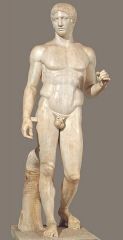
|
Polykleitos, Doryphoros c. 450 BCE (5thc BCE)
Greece |
|

|
Praxitiles, Hermes and Dionysos Roman copy of a 4th century original
Greece |
|
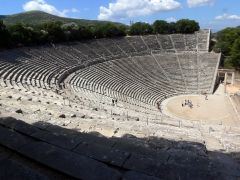
|
Theater at Epidaurus 4th century BCE and later
Greece |
|
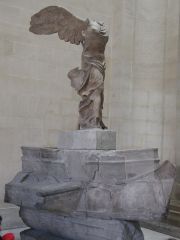
|
Nike of Samothrace c. 150 BCE (2ndc BCE)
Greece |
|
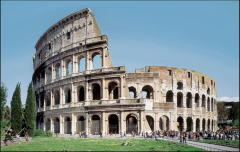
|
Flavian Amphitheater ("Colosseum") 1st century CE
Rome |
|
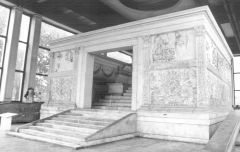
|
Ara Pacis 14-9 BCE (1stc BCE)
Rome |
|
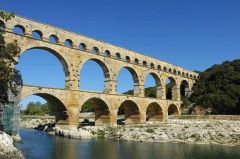
|
Aqueduct at Nime 1st century BCE
Rome |
|
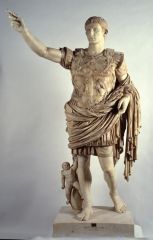
|
Augustus of Primaporta 1st century CE
Rome |
|
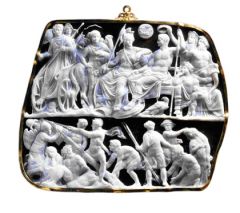
|
Gemma Augustae 1st century CE
Rome |
|
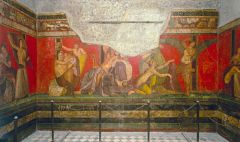
|
Villa of the Mysteries, Pompei before 79 CE (1stc CE)
Rome |
|
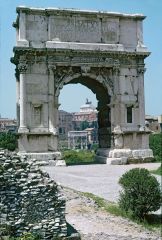
|
Arch of Titus c. 81 CE (1stc CE)
Rome |
|
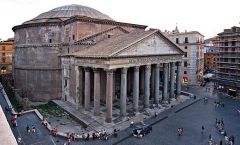
|
Pantheon c. 125 CE (2ndc CE)
Rome |
|

|
Arch of Constantine c. 320 CE (4thc CE)
Rome |
|
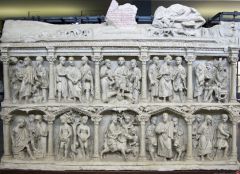
|
Sarcophagus of Junius Bassus 359 (4thc) CE
Early Christian
Roman classical with Christian ideals Christian Burial Heaven and earth Christ (w/ Roman god) Transitioned to Christianity |
|
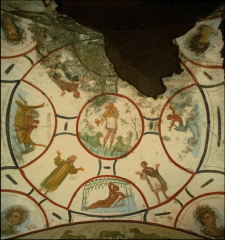
|
Catacomb of Saints Peter and Marcellinus late 3rd-early 4th c.
Early Christian
Properly preserving Christian soul Orant prayer (hands up) Roman representation of Christ (young apollo) Old testament stories (background new) Divine center and light |
|
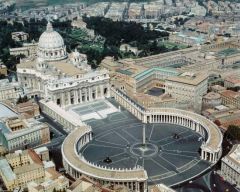
|
Basilica of Saint Peter Rome 4th C.
Early Christian
Adapted from Roman Gov building Baptism naive, side isles, courtyard |
|
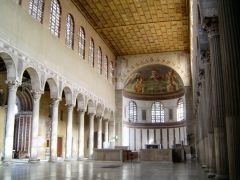
|
Santa Sabina Rome 5th C.
Early Christian
Towards end of Roman Empire simple exterior decorated interior base idea for future churches
|
|
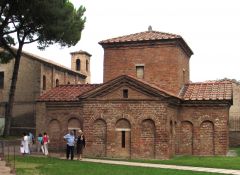
|
Mausoleum of Galla Placidia Ravenna, Italy 5th C.
Early Christian
Roman "cross" very tiny mosaics inside
|
|
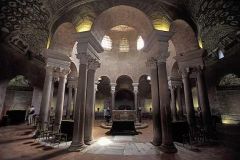
|
Santa Costanza 5th C.
Early Christian
Round, unadorned, different above ground burial dome surrounded by columns not for regular prayer |
|
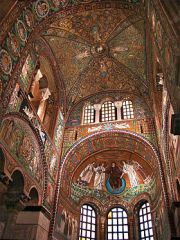
|
San Vitale 547 CE Ravenna and mosaics
Byzantine
Octogon shaped off-centered narthex ambulatory
|
|

|
Hagia Sophia C. 540 Constantinople
Byzantine
Church of Holy Wisdom Minuetes added later Complex, no clear entrance |
|
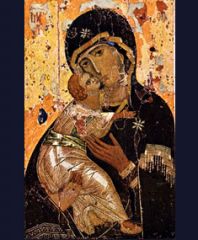
|
Virgin of Vladimir 12thc Vladimir
Byzantine
Russian cheek to cheek human, tender affection |
|
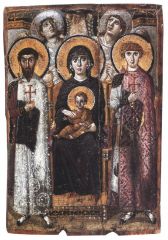
|
Theotokos Icon 6th C. Monastery of Saint Catherine, Egypt
Byzantine
Virgin becomes chair for christ |
|
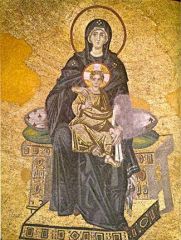
|
Virgin Enthroned Hagia Sophia Mosaic 9th C.
Byzantine
Seat for Christ wet drapery mosaic looking right at the viewer |
|
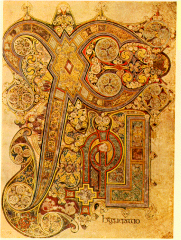
|
Book of Kells 8th C.
Early Medieval
Chi Roh (christs name in greek first letters) manuscript took a page a month
|
|
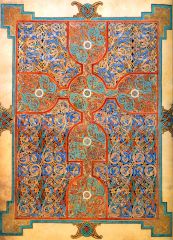
|
Lindisfarne Gospels 8th C.
Early Medieval
Carpet page Codex celtic cross/design velum/parchment |
|
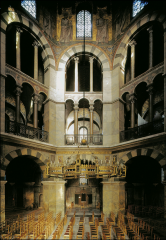
|
Palatine Chapel C. 800 (9th C.)
Carolingian
Antiquity of Ancient Rome Holy Roman Emperor of North (germany/france) Private chapel for Charlemagne |
|
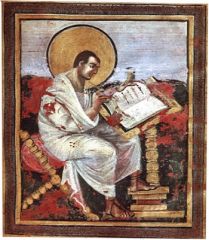
|
Coronation Gospels of Charlemagne early 9th C. colors on parchment
Carolingian
tell story of christ calm, focused process or writing inspiration virtuous |
|
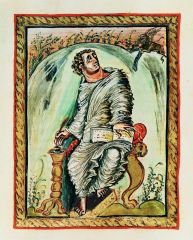
|
Ebbo Gospels early 9th C. colors on parchment
Carolingian
Symbol of Mark: lion very expressive spazzing clothes enlightenment |
|
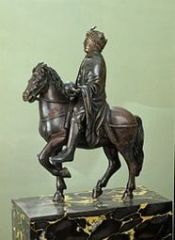
|
Charlemagne (Charles the Bald) on HOrseback bronze early 9th C.
Carolingian
Control of beast, strong orb in hand (world) not roman standard |
|

|
Saint Michael's at Hildesheim c. 1015 Hildesheim, Germany
Ottonian
two trancepts and doors on the side flat wooden roof two apses too |
|
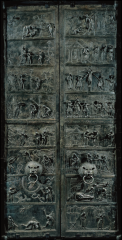
|
Bernward's Doors Hildesheim c. 1015 bronze
Ottonian
left is old testament right is new testament Bishop Bernward - visits rome body is the enemy of the spirit |
|
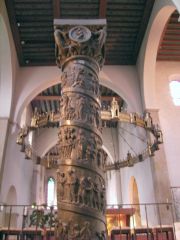
|
Bernward's Column Hildesheim c. 1015 bronze
Ottonian
Stories from Ministry of Christ what was left off of the doors Dance of Solome |
|
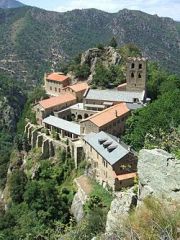
|
Saint Martin of Canigou C. 1000 BCE
Romanesque
Large mountain range monestary graceful and thoughtfully built |
|

|
Senanque abbey C. 1000
Romanesque
roman arch windows load-bearing walls cloister internal courtyard and ambulatory |
|

|
Saint Sernin Toulouse 12th c.
Romanesque
Altar created later barrel vault/tunnel vault altar at transac intersects apse and radiating chapels |
|
|
Early Christian Art |
Overlaps late classical Roman 313 Edict of Milan (christianity legal) 325 First Ecumenical Council at Nicaea Constantine moves capital to Constantinople (330CE) Symbolism and narrative (don't be pagan) |
|
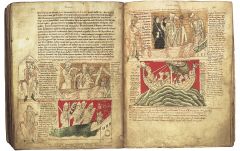
|
Chronicles of John of Worcester, Dreams of King Henry I 12th C. Manuscript
Romanesque
Taxes are too high - all the social classes narrator illustration earliest known chronicle of contemporary events in england |
|
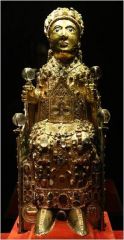
|
Reliquary of Sainte Foy Conque 9th-10th century
Romanesque
Holds skull of little girl wanted to be christian - becomes matyr
|
|
|
Byzantine Art |
325 - 1453 Orthodox Church Nicene creed to ottoman turks Rome falls 476 Iconoclasm |

